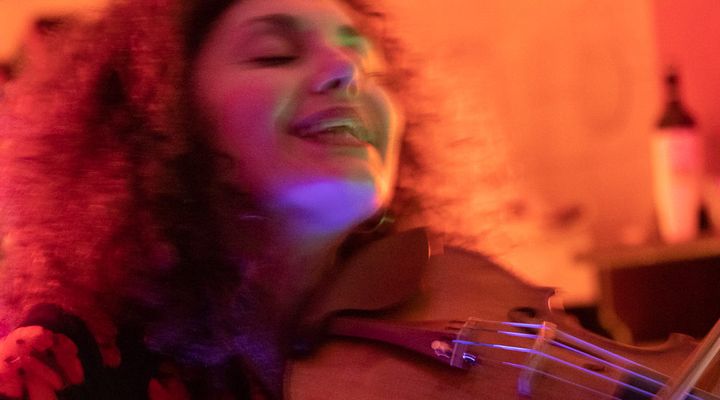Live: Éliane Radigue – OCCAM @ St Paul's Church Southville, 06/02/2017

Sound emerges. Slowly, a single trumpet note presses out of the chrysalis of breath, protruding a little more each time. I’ve heard Nate Wooley improvise before. He can be furious, virtuosic. In fact, prior to the start of his performance, I hear him warming up at the back of the church basement with quick flurries of notes that clamber up and down again, cycling effortlessly through the pitches with aerobic and masterful flair. Yet when his instrument interaction is overseen by the compositional instructions of Eliane Radigue, he’s made to play as though he must regain its trust. For the first few minutes – during which he exhales through the instrument, deeply and quietly, over and over again – the trumpet is gradually acquainted with the human breath, familiarised with gentle warmth and moisture and air flow. Player and instrument start to align and a note begins to emerge, extracted like a thread unspooled from a blanket, teased out, thickening with each blow, spreading further into the space, imbuing the emptiness with heat and colour. For the final section of the piece, Wooley rises out of his chair and twists slowly back and forth, emitting a guttural drone that sounds like a fog horn stuck in a low-energy leakage, faltering gently as it whirrs, undulating in volume as Wooley veers away and toward me. I hear the nasal hiss of his circular breath, like a tiny hydraulic piston keeping the drone perpetually alive.
Dominic Lash’s double bass performance enacts a similar process of awakening. The pressure of his bow against the strings increases over time, guided back and forth and pulling out harmonics one after the other, while low frequencies start to flare through the instrument body. Eventually, what started as a drone becomes anything but; it’s like a drum roll of harmonic pulsations, with frequencies feuding for space and juddering through the wood and the air, adorning the low tones with half-existent, half-hallucinated gleam and shimmer. I hear the seams in Lash’s continuum; the drone jumps slightly as the bow changes direction, instigating friction and resonance over and over again. That’s the wonderful thing about Radigue’s acoustic pieces: thanks to the limitations of human performance, which works in finite gesture rather than uninterrupted flow, she can’t fully recreate that sensation of mercurial eternity that runs through so many of her electronic works. Instead, the performers strive for endlessness the best they can, which only further illuminates their mortal lapses and edges.
I could watch Rhodri Davies perform with the sound off. The way his bow changes direction is so exact that it’s like a video loop alternating between forward and reverse, his arms deftly divorced from the stillness and relaxation of the rest of his body, each hand beautifully synced with the other as he drags two bows across the harp strings. Where the other two performers draw sound out of silence, gradually intensifying the vibration until tones start to take shape, Davies’ performance works the other way. It’s a thinning process. He starts with a low hum – illuminating the harp for its every physical characteristic and inconsistency, from the rattle of the string holes to the slight muffle of the wooden glaze – before elegantly ascending in pitch, climbing through the octaves and diminishing into slighter, quieter tones, withering in the darkness of the church basement. He brushes a handheld fan against one of the high strings, which chops the drone into thousands of tiny shivering beads, almost imperceptible now, flickering like the tealights at Davies’ feet. For the final minute, he plucks the strings one at a time, flicking silence with his index fingers. The sound dims and vanishes, sheathed once again, returning both player and instrument to state of quiet innocence.


